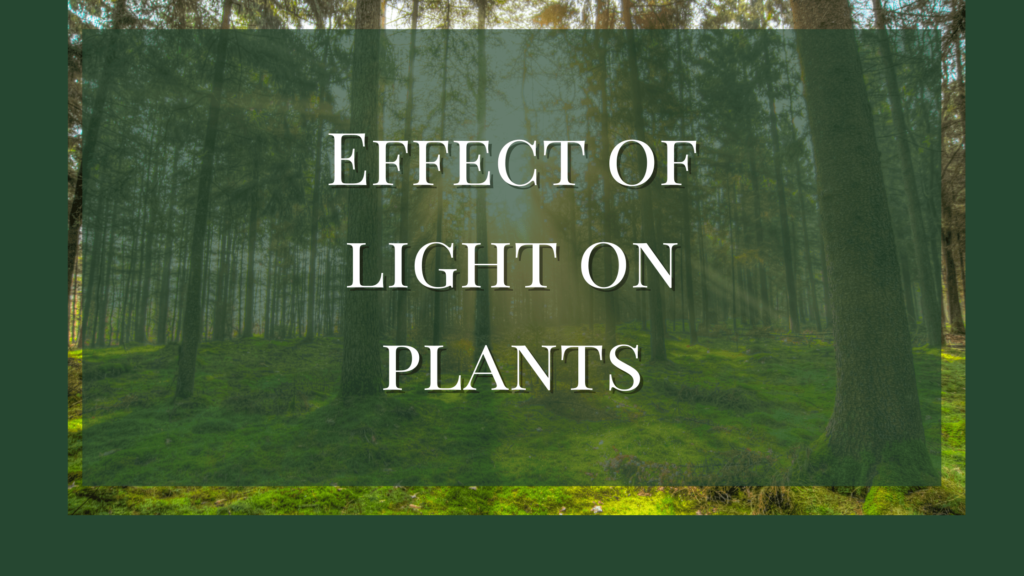Being a small object in the universe, the earth receives only 1/50th million of the total solar radiation in the universe. Of this, only 47% of the radiation reaches the biosphere and the rest is scattered or lost. This available energy and its proper utilization is important for plants.
The effects of light on plants depend on various factors such as intensity, duration, etc. The light that falls on the leaves may get reflected, absorbed, or transmitted through it. Such energy can affect various physiological activities inside the plant. These activities include different aspects of the plant life.
Effects of Light on Photosynthesis
Plants use only 2% of the light energy for photosynthesis. It is the red and blue-green light that is absorbed for photosynthesis. The rate of photosynthesis is greater in intermittent light than in continuous light.
Light is important for the development of plastids and pigments. It also affects the position and number of chloroplasts, with more chloroplasts on the upper leaf surface. The high-intensity light increases the photo-oxidation of enzymes, which will reduce the rate of synthesis of both proteins and carbohydrates.
Effects of Light on Respiration
Light has an indirect effect on respiration. Respiratory substances are produced in the presence of light, In certain plants, the respiratory rate could be proportional to the light intensity.
In some cases as in shade or under water, the low intensity of light could slow down the photosynthesis rate. Here, photosynthesis will just be sufficient to meet the respiration needs. This is called the compensation point.
Such increase and decrease in respiration may be due to the effect of light on the permeability of plasma membrane, photo-oxidation of enzymes, and change in viscosity of protoplasm. Both permeability and viscosity increase with light intensity and then reach an optimal level.
However, the effect of light is very low in thallophytes and other lower plants.
Opening and closing of stomata
Light intensity causes phosphorylation and conversion of starch into sugar in guard cells. This will increase its osmotic pressure causing an inflow of water to guard cells. This increased turgidity of these cells widens the gap and opens the stomata. When light is low or absent, these events are reversed and the stomata closes.
Effects of Light on Plants’ Growth and Flowering
Light directly affects the growth and flowering of plants. Plant growth depends on the intensity, quality, direction, and duration of light.
- High intensity of light reduces the production of auxin thereby affecting its size and shape.
- Plants that get insufficient light produce more auxins causing them to elongate and be slender with smaller leaves.
- Red light favors plant growth.
- Shorter wavelength light except violet, can slow down plant growth.
- Duration of light or photoperiod is also important for plants. According to the duration requirements plants are divided into three,
- Long-day plants that need more than 12 hours of light
- Short-day plants that need less than 12 hrs of light
- Day-neutral plants that show little response to the duration of light.
Effects of Light on the Movement of Plants
All parts of a plant- stem, root, and leaves, respond differently to light, The stem grows towards the light while roots grow away from the light. The leaves grow transversely and will orient themselves so that they do not overlap each other and every leaf gets as much light as possible.
Effects on Germination of Seeds
Moist seeds are sensitive to light as it can retard seed germination. The quality of light varies with each seed type. Red light promotes seed germination and far-red light inhibits germination. Some seeds need blue light for germination while some are prompted by yellow light.
References
- Shukla, R.S. and Chandel, P.S. (2001) Plant Ecology. S. Chand and Company Ltd., New Delhi.
- Verma, P.S., Agarwal, V.K. (1999). Cell Biology Genetics Molecular Biology Evolution and Ecology. New Delhi: S.Chand Co.(Pvt) Ltd.
- Chiang, C., Bånkestad, D., & Hoch, G. (2020). Reaching Natural Growth: Light Quality Effects on Plant Performance in Indoor Growth Facilities. Plants, 9(10). https://doi.org/10.3390/plants9101273
Additional Reading
- Climatic Factors: Atmospheric Moisture
- Temperature As an Ecological Factor
- Light as an Ecological Factor




